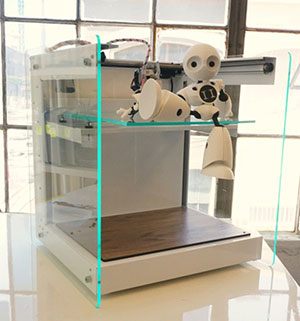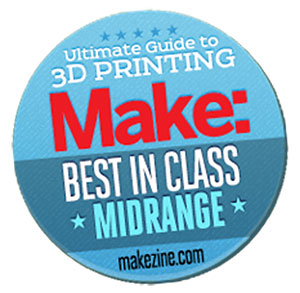Last weekend, one of our video features was Type A Machines’ CEO, Espen Sivertsen’s presentation at TEDxLivermore. Here, in 3DPI’s ongoing Executive Interview Series, Espen discusses the story of Type A Machines, maker of the Series 1 desktop 3D printer, awarded “Best in Class” by Make Magazine, with Michael Molitch-Hou. As an entrepreneur and co-founder of MemeMaker, with a BSC in psychology from the University of Manchester, Espen has helped to cultivate Type A’s thriving community and innovative marketing campaigns to ultimately create an established brand. In July 2013, after acting as COO for over a year, he took the reigns of the company from previous CEO, Kevin Rowney, and has proven that Type A’s success will only increase as his role as CEO continues.
3D Printing Industry: First of all, would you mind telling me a bit about how Type A Machines came into being? What’s the story of Type A and your role in that story?
Espen Sivertsen: The story starts back in December of 2009, when our founder Andrew Rutter bought a Makerbot Cupcake. Playing around with it, he at one point thought: I can do better. So he did. Chris Palmer up at Berkley School of Environmental Design wanted to buy a printer for his lab, so Andrew suddenly had to start thinking about building a company. He chose the name, Type A Machines, without thinking about the personality type, but it kind of stuck. It‘s not a bad thing to be detail-oriented when you are manufacturing machines. Anyway, we were all hanging out at Noisebridge in San Francisco those days, and, in January of 2012, Miloh Alexander, Gabriel Bentley and myself joined Andrew to start building Series 1 3D printers. The founding team are all pretty tech-oriented, so my own contribution has been towards the organizational side. We‘ve been scaling pretty hard ever since, and are fifteen people now.

Espen Sivertsen: Yes! Our next generation Series 1 [see picture] will have a 12 x 12 x 12 inch build volume, be WiFi enabled and have a whole host of other upgrades that we will be rolling out over the next couple of months. Our approach is to make it easy for users to upgrade when new technology becomes available, rather than have to buy a whole new printer. WiFi enabled 3D printing will make our printers much easier to operate, and enables integration with online services.
3D Printing Industry: Type A has an open house at TechShop every Wednesday, is that right? Can you tell us a little bit about the Type A community? Who are they and how important are they to the success of the Type A brand?
Espen Sivertsen: We measure our success largely through our users, both in terms of hard growth numbers and direct feedback.
Each Wednesday evening open house is an informal show and tell session we do once a week from 5.30 to around 9pm in the evening (though some people stay later). It’s really a space for people to show their prints, builds, get help and to explore and hack 3D printers. We encourage people to bring other 3D printers too – in fact anything relating to 3D printing. In this way we engage the entire technological ecosystem. We’ve got a pretty diverse community, ranging from makers to designers, architects, engineers and educators.
Chris, Jonas, Justin; Rod, Andrew, Jared, Eric; the list goes on… Each one of our users helps us push the envelope on what is possible, and helps guide our culture towards one of accessible source, easy to use interfaces and reliable results. If not – they let us know, repeatedly!
3D Printing Industry: How important is the greater San Francisco community to the development of Type A Machines?
Espen Sivertsen: Being based inside of TechShop San Francisco definitely has its advantages. For one, I think San Francisco benefits from the Bay Area talent magnet, and, so, we’ve got a bunch of really, really great people working with and for the company. We have highly-qualified engineers and architects working our assembly line, because they believe in what we are doing and think it is fun. The other thing about being in San Francisco is that we are intimately connected to the software side of things – something I think you will hear more about in the months to come.
3D Printing Industry: I’ve seen that you have used some social media platforms to explore business development, using Reddit, for instance, to try and launch a product. How does social media play in the development of a business?
Espen Sivertsen: Reddit in particular fascinates me: what better place online to share knowledge, links and thoughts? And pictures of kittens riding narwhals spearing bacon? The internet is a vast space, and each social media platform has its own written and unwritten rules about what is acceptable and what is not. For me, it comes down to understanding what is of value to each space, and ensuring that we bring value with us wherever we go. As such, we are just starting to feel our way onto Facebook, reddit, Twitter, LinkedIn, G+, etc. My impression is that most communities are ok with companies having a presence, as long as they don’t spam, comply with the rules and bring value in the form of content, support and insights. In return, the community can, with time, become a supporter of your brand, and help promote and even defend you when someone is wrong on the internet.
3D Printing Industry: I love some of the projects Type A has worked with, such as Printers for Peace, and contests its launched, like Desktop Warfare and the DefCon Hacking contest. Is Type A driven by a particular ethos or philosophy that leads it to choose such contests and partners?
Espen Sivertsen: The Type A Team believes in empowering people to build great things. We believe that iterative design leads to great design, and that the best way to learn is by doing. This leads us to naturally seek partners, and (more often than not) have partners seek us, that share our passion for education, exploration and – let’s face it – craziness. If it doesn’t sound insane, it’s probably not going to be fun.
3D printing has a tremendous potential to do good things for our planet and people. Encouraging people to get creating, explore solutions and to familiarize themselves with technology is going to be a large part of that.
3D Printing Industry: How did you get involved with 3D Printers for Peace and Michigan Tech?
Espen Sivertsen: One of our employees – Scott Albritton – recommended we speak with Joshua Pearce at Michigan Tech. At the time, a lot of folks were just starting to hear about the ability of 3D printers to make guns. We all wanted to change the dialogue; 3D printers are a tool, and like any tool they can be used for good or bad things. We wanted to focus on water filtration systems, prosthetic limbs and education. Not death and destruction. Joshua offered us the perfect opportunity.
3D Printing Industry: Do you have a particular favorite project/contest that Type A has launched or been a part of?

3D Printing Industry: There was a recent change in leadership at Type A. Is there anything you’d be willing to tell us about why Kevin Rowney stepped down and how you came to take over?
Espen Sivertsen: We are all very grateful to Kevin for spending his time with us and helping us learn about and grow our own values and direction. Kevin is a smart and highly skilled guy. The shareholders had some differences in vision and execution, and at the end of the day Kevin chose to step down. Our founder Andrew Rutter has seen me perform the last 18 months and asked me to take over. There is no foundation to the rumors that any of this is because Kevin “accidentally” fired a nerf-launcher in Andrew’s face at point blank range on the same day he started work for the company.
3D Printing Industry: At 3DPI, we’re tired of asking the question “What do you think about this 3D printed gun?” Instead, I’d like to get your opinion on two other developments. Another sensationalized story came out about the potential harm that ultrafine particles and fumes emitted from 3D printers can do. What’s your take on that story?
Espen Sivertsen: Actually, both 3D printed guns and ultrafine particles are real concerns – particularly to schools and large companies that worry they might face legal action. Like any tool, 3D printers need to be used responsibly, and we work to ensure that this is the case. There are cost effective steps that can be taken as regards safety and 3D printing, such as structured use in schools, and HEPA filters as regards ultrafine particles. As regards particles, I think it is worth noting that we’ve been using PLA as our core material since the beginning, as it is a biodegradable and non-toxic plastic. Using PLA in 3D printing is about as dangerous as lighting a scented candle in your bathroom. That said, we will over the next couple of months be branching into more exotic materials, and appropriate air filtration needs to be part of that.
3D Printing Industry: Secondly, what are your thoughts on the acquisition of Makerbot by Stratasys? Is the Maker movement changing, becoming commercialized and mainstream? If so, how does this affect the Maker movement?
Espen Sivertsen: It will be interesting to see how Makerbot’s merger with Stratasys goes. It’s certainly peaked a lot of investor interest around here. Makerbot has a lot of units in the field, and hopefully Stratasys technology can help make them more reliable. I am also curious to see to what extent their next product will be modifiable by the community. Judging from their latest release – the Digitizer 3D scanner, I’m going to go out on a limb and say not very much. It’s sad because they lose such a great source of innovation and community involvement when they take away access. It’s a massive R&D opportunity and they’ve lost it.

Judging by the number of people attending Make Magazine‘s Makerfaires, the Maker movement is growing rapidly. I think part of that growth involves lowering the barriers for participation – making it easier for novices to get involved in hardware projects. More people are good for the community: it enables existing community members to quit their day job and start doing what they love full time. Having the skills to make is vital for job creation too: our hardware startup is employing 15 people full time as the result of Andrew’s tinkering two years ago. And we are hiring by the way.
Providing professional services have to be part of opening up too. A lot of the Maker hobbyists are engineers, designers and architects in their day jobs, and want to see 3D printing and other tools introduced into their offices. We at Type A Machines are working hard to enable that – bearing in mind that workplaces need reliable machines that are easy to service and upgrade. So that’s what we’ve built.
Finally, as interviewer and sufferer of chronic weltschmerz, 3DPI’s Michael Molitch-Hou had to ask the questions he feels lay at the heart of all interviews:
3D Printing Industry: What is reality? What is the meaning of life?
Espen Sivertsen: Reality is context sensitive. The meaning of life is to crush your enemies, and see them driven before you. At least when it comes to desktop warfare. For everything else I would misquote Gandhi: Be the change you wish to see.



